After leaving the Earth's atmosphere, space objects remain without any technical support, but this situation may change in the coming years. After a successful experiment in space towing, the United States intends to create full-fledged refueling satellites that prolong the life of objects in orbit.
Yesterday, October 16, the portal defensenews.com He reported that the US Air Force Research Laboratory has signed a contract with Orbit Fab to test a valve for space refueling. Flight tests will take place in the near future and will show the possibility of transferring fuel from satellite to satellite.

Rendering of a tanker satellite
Image source: defensenews.com
If the experiment is successful, promising satellites can begin to be equipped with refueling valves, and a network of refueling stations will start operating in orbit. This can significantly change the approach to the design of satellites, as well as extend their service life.
The Agency for Advanced Defense Projects (DARPA) of the US Department of Defense has been actively engaged in projects aimed at creating "service stations in orbit" for several years. Last year, the experiment with connecting the MEV-1 tow satellite to the IS-901 device was successfully completed, which will allow the latter to serve for at least another five years.
The National Aerospace Agency (National Aeronautics and Space Administration, NASA) plans to refuel the Landsat 7 satellite, launched into orbit in 1999. In addition, the "orbital service stations" will allow the US army not only to repair its satellites, but also to protect them from "outside interference", and, if necessary, to damage enemy space objects. At the same time, the US Department of Defense immediately announced that it does not plan to use orbital mechanical robots for offensive purposes.
